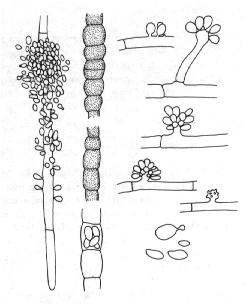Main page <> Index of descriptions <> Previous description <> Aureobasidium <> Next description

Aureobasidium
This is one of several genera of "black yeasts", characterized by mostly slow-growing, black, pasty colonies. The spores are produced in great masses along the filaments and occur on short lateral branches or pegs. When the spores are released they leave minute roughened scars. Exophiala species are similar but the spores do not leave rough scars as in Aureobasidium. Black yeasts occur in many habitats; some species of Exophiala may even cause human disease. Aureobasidium pullulans, the most frequently reported and possibly only species of Aureobasidium is a common inhabitant of the phylloplane (leaf surfaces) but is also frequently reported from soil, wood, rocks stone monuments and human skin. Stone buildings that have become black over the years often have abundant growth of A. pullulans.
Classification: Dothioraceae (Dothideales). Holomorphs unknown. Ref: Hoog and Hermanides-Nijhoff 1977; Hoog and Yurlova, 1994; Takeo and Hoog, 1991